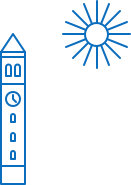Study in USA


Capital Washington DC

Currency US Dollars

Language English

Population 332 Million

GDP $ 21.44 Trillion

Dialling Code +1
With over 3900+ universities/institutes across the country, the United States of America (USA) has dominated the globe in being the most popular university destination for students from all over the world. U.S. degrees have an excellent international reputation. Along with the quality education, USA has emerged as a leader in research and innovation in the world
Here are the TOP 5 reasons why you must consider studying in USA:
Most universities in United States have 3 intakes for International students:
| Fall Intake | Starts in August / September |
| Spring Intake | Starts in January / February |
| Summer Intake | Starts in April / May |
The Fall intake (Aug / Sep) is the primary intake in USA its this time that universities and departments commence their flagship and major programs. A wide variety of courses are offered. If you have missed the fall intake then you can apply for the Spring intake (Jan /Feb). The Summer intake (Apr or May intake) is not offered by all universities and institutes. Mostly it’s for English language programs and shorter duration programs.
You must consider the fact that the deadlines for applying to an intake are usually 4 to 5 months before the date of the starting of the semester. Universities have limited seats and competition is intense. So start your process at least 6 to 7 months before the intake. Most universities usually take about 7-10 weeks to process the applications.
There are 3 types of student visas:
F1 Student Visa
The F-1 visa is a non-immigrant visa for all those wishing to study in the United States. You must file an F-1 visa application if you plan on entering the US. to attend a university or college or any academic institute.
J1 Exchange Visitor Visa
The J-1 visa is a non-immigrant visa issued by the United States to research scholars, professors and exchange visitors participating in programs that promote cultural exchange, especially to obtain medical or business training within the U.S.
M-1 Vocational/ Non-Academic
The M-1 visa is a type of student visa in the U.S. reserved for international students attending vocational schools and technical schools.
Employment opportunities for international students while studying are limited. You should not plan on earning substantial money from a part-time job to help pay for your studies.
F1 student visa holders cannot work in any off campus employment during the first year of their studies. IN certain circumstances the U.S. Citizenship & Immigration Service (USCIS)may grant permission to certain student s for off-campus employment only after one year of study. Students can however accept on-campus employment at their university. These on-campus jobs are often difficult to obtain and do not provide sufficient funds to sustain education costs. Students with good academic standing have a better chance.
Choosing a university/college is one of the biggest decisions that you will make in terms of your education and it can be overwhelming and confusing. Here are a few important factors for you to consider while choosing the university
Our US expert advisors will guide you thru this entire process.
The USA remains the world’s most popular destination for international students however it’s also among the most expensive choices in terms of tuition fee.
Universities in the USA are majorly divided into two categories :
The education cost at a public/state university is comparatively lesser than that of a private institution. Your expenditure on tuition fee depends on the type of qualification and university or school you opt for. Below is a indicative cost for different programs
| Program Type | Indicative Tuition fee |
|---|---|
| English Language Studies | $ 1000 to $ 2000 a month |
| Community Colleges | $ 8000 to $ 18000 per year |
| Undergraduate studies | $ 19000 to $ 32000 per year |
| Graduate Studies | $ 20000 to $ 50000 per year |
| Doctoral degrees | $ 26000 tp $ 55000 per year |
For more specific details, please contact us or see the university/college websites
The GPA (Grade-point average) is the system in USA and followed by most universities. Its calculated on a 4-point scale (1 to 4), with 4.0 being the highest. The GPA can bea combination with letter grades.
The chart below shows you how much each letter grade is worth in number of points to GPA:
| A = 90-100% | 4 |
| B = 80-89% | 3 |
| C = 70-79% | 2 |
| D = 60-69% | 1 |
| F = <60% | 0 |
GPA is very important in US universities and students must keep a certain level of GPA to obtain scholarships or get admitted into a course.
The Grade point average can be calculated on a 4-point scale which is considered as the international standard followed by US universities.
The I-20 form is issued by the US university as a confirmation of an your admission into a program. It certifies that you:
You will need Form I-20 to obtain a student visa or to keep lawful F-1 status in U.S. This document is issued by SVEP (Student Visitor and Exchange Program) certified universities/institutes and includes the SEVIS ID which is unique for each student.
Once you receive the I-20 (Admission Letter) then you can start the visa application procedures.
Before attending your interview, you will need to have the following documents :
Proof of sufficient funds
International students who have an F-1 and M-1 visa are allowed to work on-campus and in specified training programs. Students are not allowed to work off-campus during their first academic year. On-campus jobs are student oriented such as working in the library, cafeteria, or student center.
Note: Employment opportunities for international students while studying are limited. You should not plan on earning substantial money from a part-time job to help pay for your studies.
You will undergo personal interview with the visa officer at the US Consulate and the visa officer may ask the students various questions related to their past qualification, why they want to study in the USA, their future plans and goals, family background, how you want to fund your studies etc. to determine the students genuine intentions.
SEE : US Student Visa Interview Questions
Once your finish undergraduate or post-graduate course from a US university, you can opt for the below work options:
Optional Practical Training (OPT) is a program that allows international students in the United States to work temporarily up to 12 months. OPT can be completed both before or after completing your studies, but it’s important to remember that you are only allowed to work 12 months total including pre-completion of degree and post-completion of degree.
OPT Extension for 24 months: If you have earned a degree in certain science, technology, engineering and math (STEM) fields, you may apply for a 24-month extension of your post-completion OPTS employment authorization.
Curricular Practical Training (CPT): This is an employment option available for students where practical training employment is considered to be an integral part of the academic program. CPT is defined to be alternative work/study, internship or any other type of required practicum that is offered by sponsoring employers through cooperative agreements with university / colleges. CPT requires that the students have a valid student visa for minimum 9 months and are in proper standing in terms of academics and GPA.
H1B Work Visa :The H1B visa is the official and primary USA work visa available to people from all around the world. This visa allows US companies to employ graduate level workers in specialty occupations that require theoretical or technical expertise in specialized fields such as in IT, finance, accounting, architecture, engineering, mathematics, science, medicine, etc. The United States Citizenship and Immigration Services sets a limit on how many H1B visas are issued each year. These numbers can change as per regulations of the US One of the main advantages of the H1B visa is that it’s a “dual intent” visa which means that one can apply for Green card (legal permanent residency).
The H1B visa is typically valid from 3 to 6 years and entitles spouses and children to accompany the main applicant. (Note : Please check the relevant USCIS website for latest information on H1B Visas)